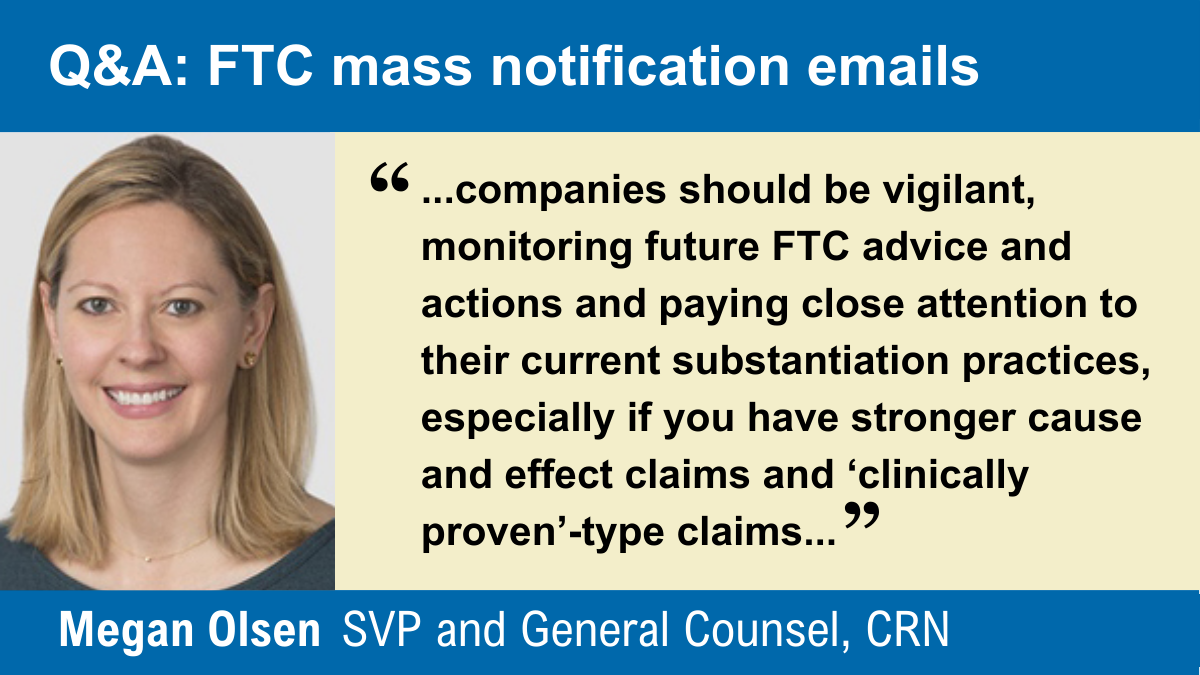On April 13, 2023, the Federal Trade Commission sent “notice of penalty offenses” to about 670 companies reminding them that they should not be making product claims that cannot be substantiated. Many of CRN’s members, along with members of other trade associations, were on the list. CRN’s Megan Olsen sat down to explain what the Commission’s actions might mean.

Q: What do these notices mean to the supplement companies that received them?
Megan: So, it doesn't mean that they engaged in any wrongdoing. I think that's the first and most important point. FTC is using these notices as a tool to make it easier to collect fines in the future, should a notified company violate the Federal Trade Commission Act.
Q: But why send out a blanket notice?
Megan: Because there's a little bit of history here. There's a Supreme Court case a few years ago called “AMG Capital Management” that severely limited the FTC's ability to collect fines against companies. They used to be able to collect what's known as consumer redress in general (Section) 5 violation cases. That's where the FTC would establish that a company engaged in an unfair or deceptive practice, such as not having adequate support for a claim, and then say because of that violation a company must give consumers back the money made from the violation. These cases differ from violations involving regulations created by FTC that govern very specific conduct, such as rules on telemarketing practices, where the FTC is allowed to collect pre-determined civil penalties. Consumer redress was designed to address conduct that fell outside the specific trade rules, return money backed to harmed consumers, and help ensure companies didn’t monetarily benefit from deceptive practices.
Consumer redress amounts were generally determined through lengthy negotiations with the FTC and differed greatly in amounts but could substantially impact businesses as the FTC sought to recover all income from the deceptive practice, regardless of the company’s costs to manufacture, advertise, and other expenses associated with the sale of a product. But FTC lost that ability, and they've been asking Congress and exploring other tools to get back some type of authority to collect monetary penalties in all cases, not just those involving trade regulation violations.
Q: So, these notifications set the stage to make it easier for the FTC to collect civil penalties from a company down the road, should they decide to?
Megan: Yes. What went out to all of these companies is something called ‘a Notice of Penalty Offenses, and it’s a tool that the Commission is using to try to enact their civil penalty authority for general Section 5 violations.
Q: Do you feel like this mass notification is a signal that the agency’s enforcement posture around claims may change soon?
Megan: Yes. Specifically, I think there's two things going on here that I think are worth pointing out to members and industry.
First, we need to remember that the FTC came out with updated substantiation guidance for health products claims in December. They're clearly concerned about all products that talk about health benefits, not just supplements, but supplements make up a big portion of the products on the market that are advertised for their health benefits. There’s no doubt they're focused on our industry right now.
Secondly, within the health benefit claims area, they continue to be very focused on products making disease claims. While this focus is nothing new (FTC has limited resources and wants to use those on the strongest and likely most harmful claims), they seem overly and incorrectly concerned with the widespread use of these claims in the dietary supplement industry, going as far as to suggest that your local pharmacy is filled with “aisles of products” that “promise to alleviate pain, to restore lost virility, or to help cure the most deadly and tragic of illnesses.”
Our industry, of course, can't make disease claims and statements like the one referenced above made by Commissioner Slaughter are completely misplaced and don’t describe the numerous reputable companies in the industry selling high-quality beneficial health products.
That said, we're concerned that the guidance on these issues doesn't go as deep into substantiation for structure function claims as it should.
Q: So, what’s happening next behind-the-scenes?
Megan: Again, we are concerned that their focus on disease claim substantiation seems to be misplaced. CRN would like to engage with the FTC at our forthcoming legal conference, since staff from FTC is one of the speakers. We hope to glean some insight into what they expect for these structure function claims that we are allowed to make.
Q: What's the final takeaway for members regarding this agency action?
Megan: I suspect FTC’s focus is still on the most egregious disease claims. But given the updated guidance and this widespread notice to a lot of prominent companies, companies should be vigilant, monitoring future FTC advice and actions and paying close attention to their current substantiation practices, especially if you have stronger cause and effect claims and “clinically proven”-type claims—those types of claims are more likely to catch FTC’s attention versus more general structure/function type claims such as “vitamin D supports bone health.”

